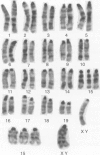Abstract
A human prostate tumour cell line, LNCaP C4-2, when injected into athymic male nude mice, produced tumours containing: (1) only human cancer cells similar to those injected; (2) only murine stromal cells containing abnormal chromosome constitutions; or (3) both human prostate cancer cells similar to those injected and the transformed murine stromal cells with altered chromosome constitutions. Karyotypic analysis of murine metaphases from all the host-derived tumours showed mostly pseudodiploid chromosome constitutions, with multiple copies (amplification) of mouse chromosome 15 and the absence of a typical Y chromosome. Fluorescence in situ hybridization analysis of these murine cells, using a biotin-labelled total human DNA painting probe, further demonstrated the absence of human DNA and the presence of only mouse metaphase and interphase cells in these transformed stromal cells. These results suggest that cancer cells are capable of inducing neoplastic transformation in stromal cells of the host organ by some, as yet unknown, epigenetic mechanism(s).
Full text
PDF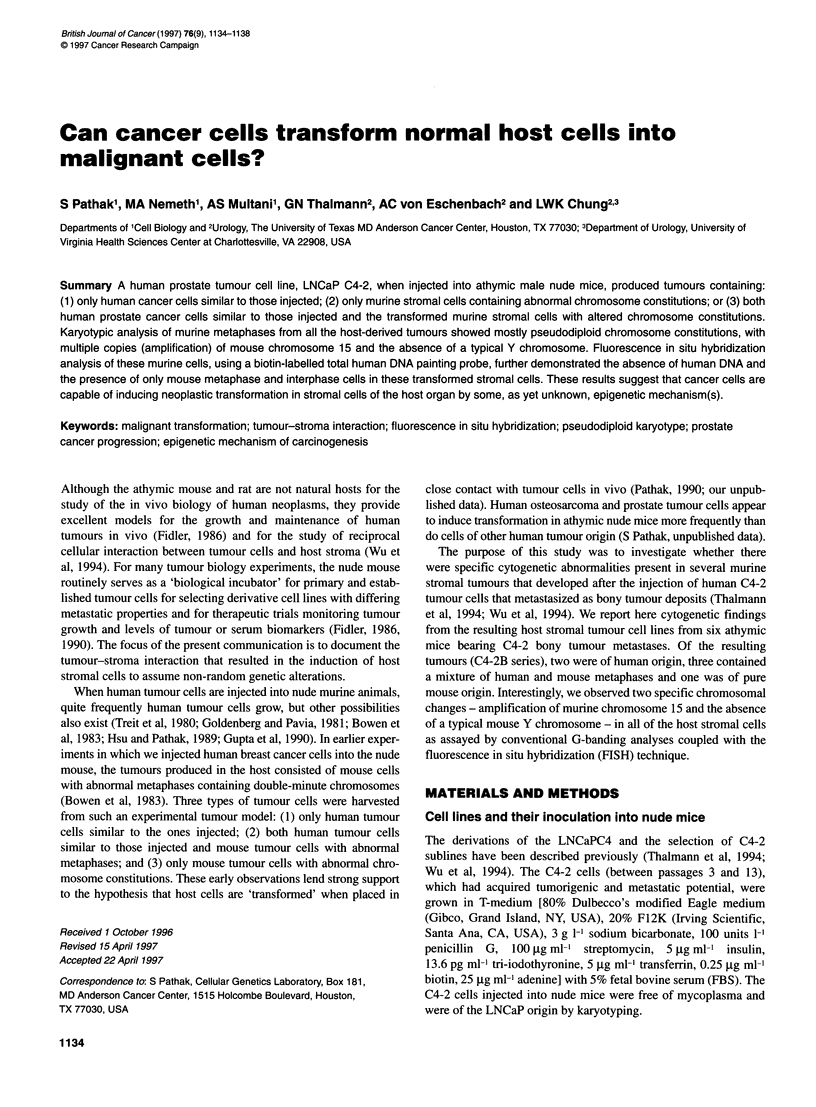
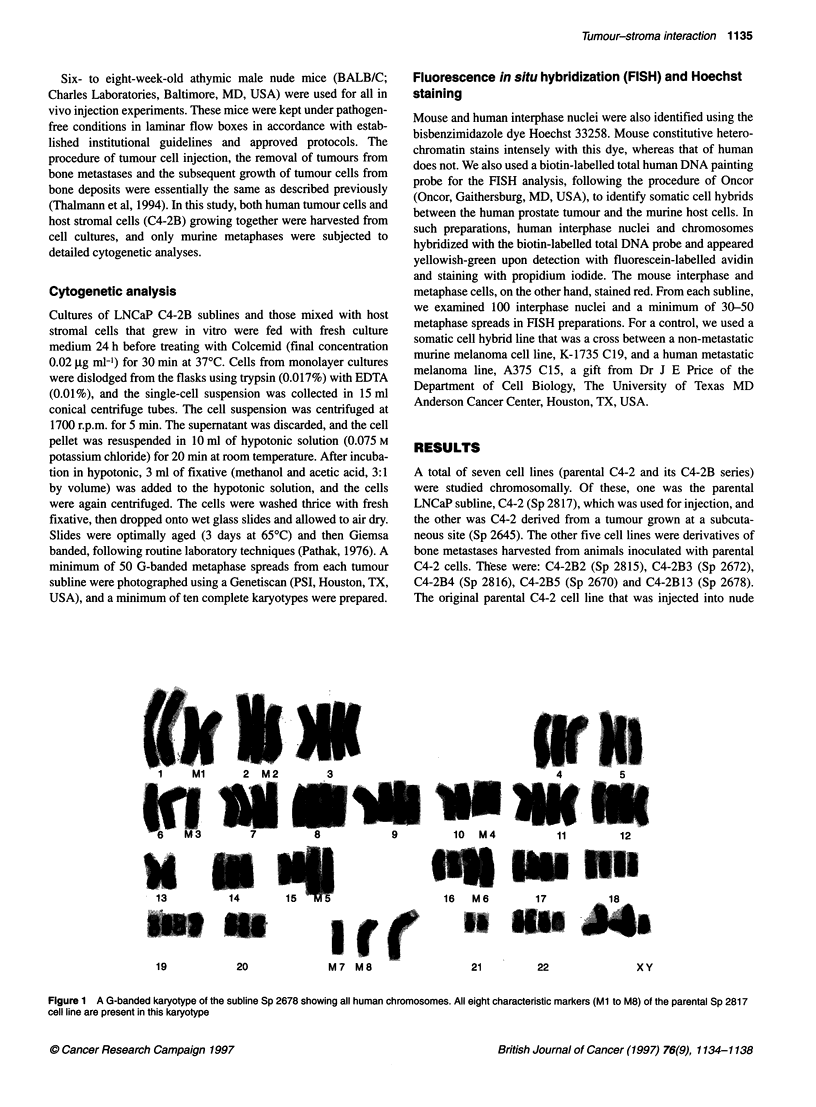
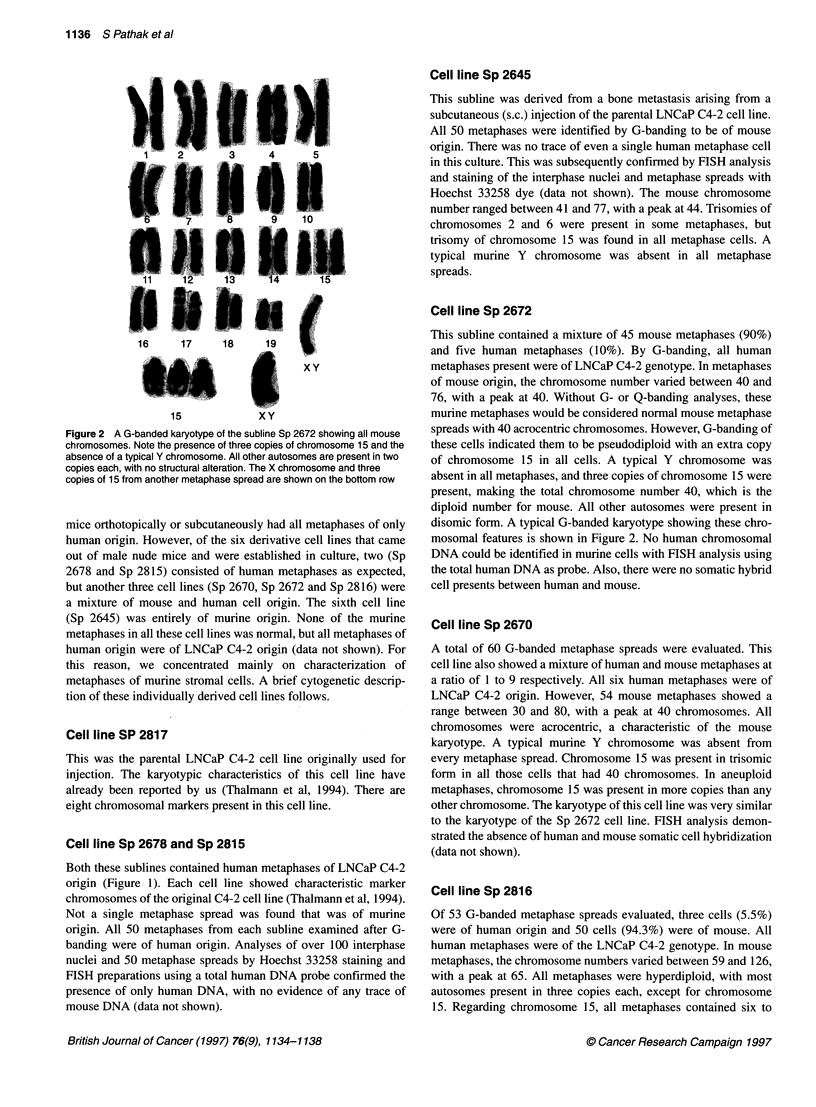
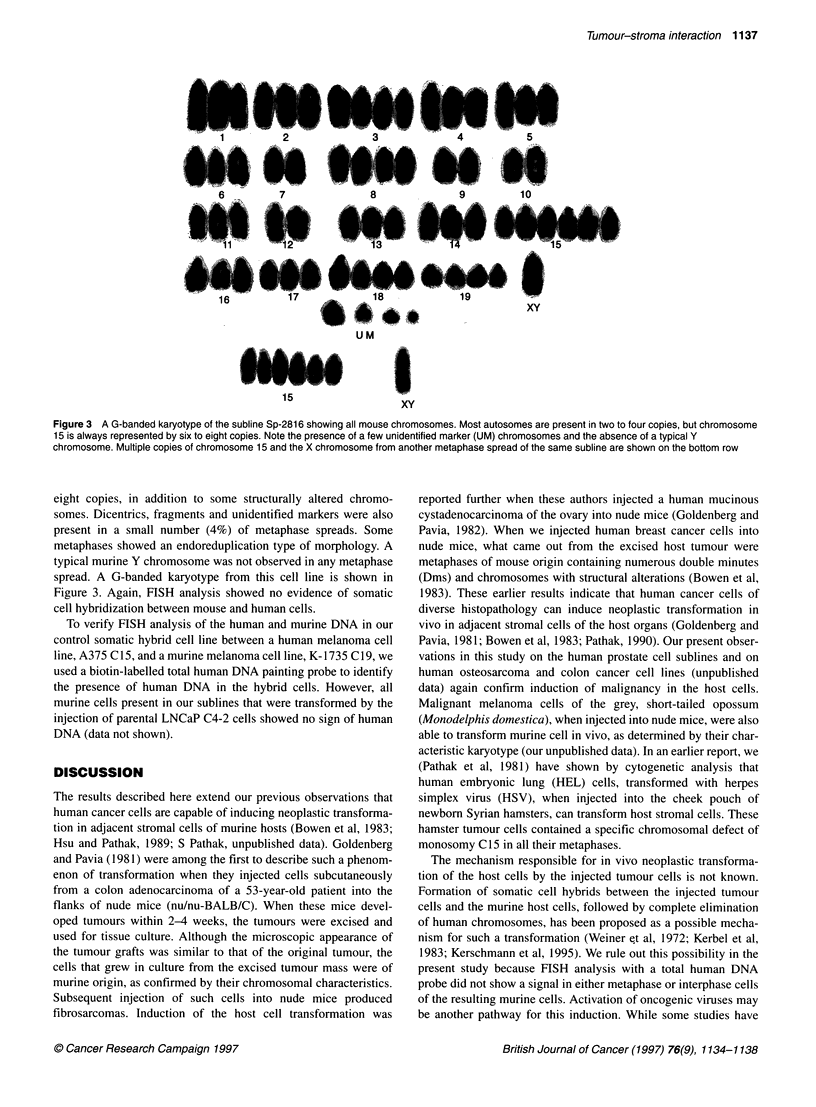
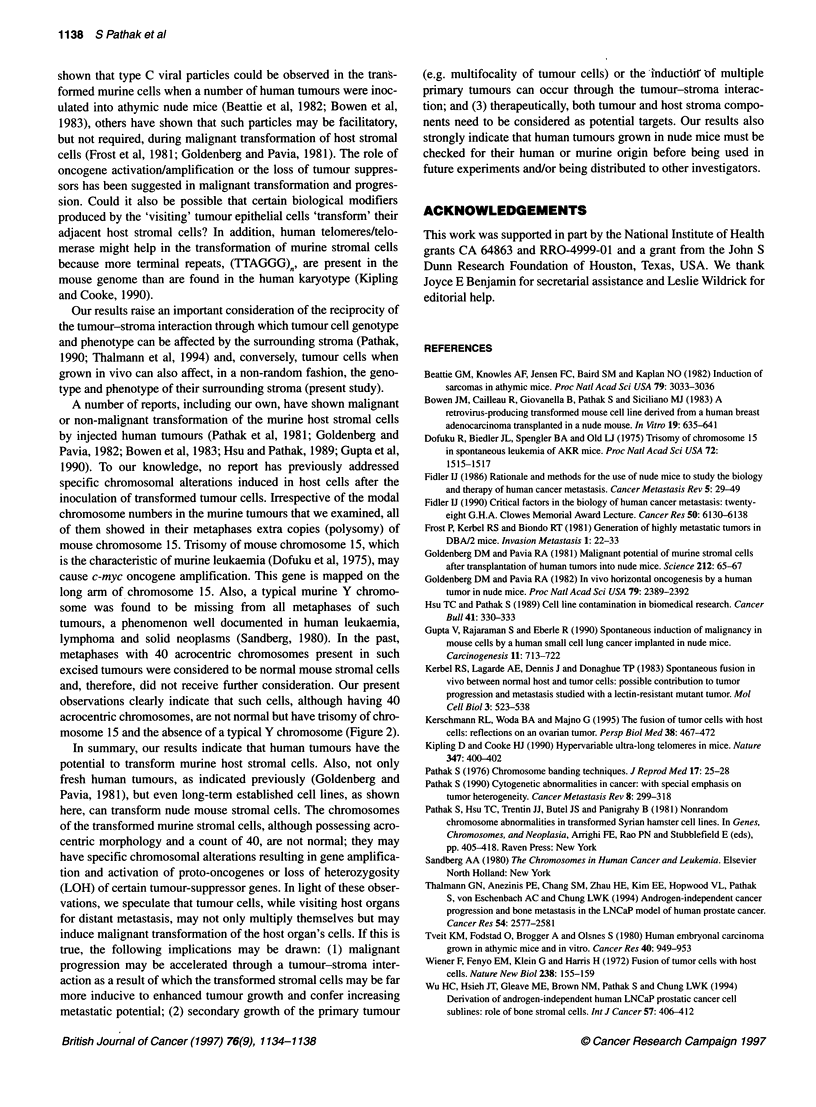
Images in this article
Selected References
These references are in PubMed. This may not be the complete list of references from this article.
- Beattie G. M., Knowles A. F., Jensen F. C., Baird S. M., Kaplan N. O. Induction of sarcomas in athymic mice. Proc Natl Acad Sci U S A. 1982 May;79(9):3033–3036. doi: 10.1073/pnas.79.9.3033. [DOI] [PMC free article] [PubMed] [Google Scholar]
- Bowen J. M., Cailleau R., Giovanella B. C., Pathak S., Siciliano M. J. A retrovirus-producing transformed mouse cell line derived from a human breast adenocarcinoma transplanted in a nude mouse. In Vitro. 1983 Aug;19(8):635–641. doi: 10.1007/BF02619577. [DOI] [PubMed] [Google Scholar]
- Dofuku R., Biedler J. L., Spengler B. A., Old L. J. Trisomy of chromosome 15 in spontaneous leukemia of AKR mice. Proc Natl Acad Sci U S A. 1975 Apr;72(4):1515–1517. doi: 10.1073/pnas.72.4.1515. [DOI] [PMC free article] [PubMed] [Google Scholar]
- Fidler I. J. Critical factors in the biology of human cancer metastasis: twenty-eighth G.H.A. Clowes memorial award lecture. Cancer Res. 1990 Oct 1;50(19):6130–6138. [PubMed] [Google Scholar]
- Fidler I. J. Rationale and methods for the use of nude mice to study the biology and therapy of human cancer metastasis. Cancer Metastasis Rev. 1986;5(1):29–49. doi: 10.1007/BF00049529. [DOI] [PubMed] [Google Scholar]
- Frost P., Kerbel R. S., Tartamella-Biondo R. Generation of highly metastatic tumors in DBA/2 mice. Oncogenicity of a strain tumor cells. Invasion Metastasis. 1981;1(1):22–33. [PubMed] [Google Scholar]
- Goldenberg D. M., Pavia R. A. In vivo horizontal oncogenesis by a human tumor in nude mice. Proc Natl Acad Sci U S A. 1982 Apr;79(7):2389–2392. doi: 10.1073/pnas.79.7.2389. [DOI] [PMC free article] [PubMed] [Google Scholar]
- Goldenberg D. M., Pavia R. A. Malignant potential of murine stromal cells after transplantation of human tumors into nude mice. Science. 1981 Apr 3;212(4490):65–67. doi: 10.1126/science.7209521. [DOI] [PubMed] [Google Scholar]
- Gupta V., Rajaraman S., Eberle R. Spontaneous induction of malignancy in mouse cells by a human small cell lung cancer implanted in nude mice. Carcinogenesis. 1990 May;11(5):713–722. doi: 10.1093/carcin/11.5.713. [DOI] [PubMed] [Google Scholar]
- Kerbel R. S., Lagarde A. E., Dennis J. W., Donaghue T. P. Spontaneous fusion in vivo between normal host and tumor cells: possible contribution to tumor progression and metastasis studied with a lectin-resistant mutant tumor. Mol Cell Biol. 1983 Apr;3(4):523–538. doi: 10.1128/mcb.3.4.523. [DOI] [PMC free article] [PubMed] [Google Scholar]
- Kerschmann R. L., Woda B. A., Majno G. The fusion of tumor cells with host cells; reflections on an ovarian tumor. Perspect Biol Med. 1995 Spring;38(3):467–475. doi: 10.1353/pbm.1995.0070. [DOI] [PubMed] [Google Scholar]
- Kipling D., Cooke H. J. Hypervariable ultra-long telomeres in mice. Nature. 1990 Sep 27;347(6291):400–402. doi: 10.1038/347400a0. [DOI] [PubMed] [Google Scholar]
- Pathak S. Chromosome banding techniques. J Reprod Med. 1976 Jul;17(1):25–28. [PubMed] [Google Scholar]
- Pathak S. Cytogenetic abnormalities in cancer: with special emphasis on tumor heterogeneity. Cancer Metastasis Rev. 1990 Feb;8(4):299–318. doi: 10.1007/BF00052606. [DOI] [PubMed] [Google Scholar]
- Thalmann G. N., Anezinis P. E., Chang S. M., Zhau H. E., Kim E. E., Hopwood V. L., Pathak S., von Eschenbach A. C., Chung L. W. Androgen-independent cancer progression and bone metastasis in the LNCaP model of human prostate cancer. Cancer Res. 1994 May 15;54(10):2577–2581. [PubMed] [Google Scholar]
- Tveit K. M., Fodstad O., Brøgger A., Olsnes S. Human embryonal carcinoma grown in athymic mice and in vitro. Cancer Res. 1980 Mar;40(3):949–953. [PubMed] [Google Scholar]
- Wiener F., Fenyö E. M., Klein G., Harris H. Fusion of tumour cells with host cells. Nat New Biol. 1972 Aug 2;238(83):155–159. doi: 10.1038/newbio238155a0. [DOI] [PubMed] [Google Scholar]
- Wu H. C., Hsieh J. T., Gleave M. E., Brown N. M., Pathak S., Chung L. W. Derivation of androgen-independent human LNCaP prostatic cancer cell sublines: role of bone stromal cells. Int J Cancer. 1994 May 1;57(3):406–412. doi: 10.1002/ijc.2910570319. [DOI] [PubMed] [Google Scholar]




